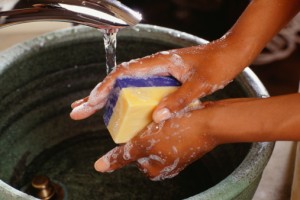More Misadventures in Foreign Aid?

(Photodisc)
Last week CNN told the story here and here of Derreck Kayongo, a refugee from Uganda now living in Atlanta. His father was a soap-maker, and Mr. Kayongo is following in his footsteps, but with a nonprofit twist: he cleans and reprocesses discarded used soap bars from American hotels and ships them to Africa. He started the Global Soap Project, a U.S.-based non-profit organization, to do this.
An inspiring story of someone trying to turn waste into something good. That of course is great, and I like the ingenuity. And I admire how Mr. Kayongo has managed to navigate both the nonprofit and corporate space to figure out how to mobilize people to contribute the soap, and to coordinate delivery to people in need.
But is the best solution here really half-used soap?
A key question that we should be asking, as with other schemes to send our nearly-disposed-of-goods overseas, is how do the cost of packaging and shipping compare to the cost of purchasing the same goods in local markets in the destination country?
Or in this particular case, there is a formula we should calculate:
We want to know the benefit to society, relative to an alternative. An alternative is to take the money that would be spent on reprocessing and shipping the soap, and instead send money to Africa to buy soap there and give it out for free (just as they are doing now, through the same channels).
Here is the formula for the net benefit to society from the Global Soap Project’s approach, compared to the above alternative:
+ Cost of soap purchased in Africa
+ Environmental costs saved by not putting soap in a land fill (I have no idea, is this bad?)
– Cost of collecting and reprocessing the soap
– Shipping costs to send soap to Africa
– Foregone welfare gain in Africa from supporting the soap-making industry
= Net social benefit of Global Soap Project, compared to sending cash and buying soap and distributing it for free
So what is this likely to be? Judging by the price of soap in many parts of Africa (very very low), I’m guessing the right strategy is to send the cash and buy soap there.
Scott Gilmore blogged this point as well. Global Soap Project responded, and explained that the soap is shipped over by charities already shipping stuff, so Global Soap Project is not paying for the shipping. Although I admire the entrepreneurial instinct, to find others to send the stuff at lowest possible cost, the fact remains that there is a cost to doing that. Just because Mr. Kayongo found someone to pay for the shipping doesn’t mean it got shipped for free.
In the interview, Mr. Kayongo says, “I don’t want to ever see a child without soap. I don’t want to see a mother give birth where the attendant didn’t wash her hands. I want to put a bar of soap in every child’s hand globally that cannot afford it. That’s my goal.” An admirable goal. Clearly Mr. Kayongo has good intentions. And I smile at the entrepreneurial spirit. But is his current approach the most cost-effective way of achieving this goal?
If indeed the calculation leads to the conclusion I think it will, I hope someday soon we will hear about Mr. Kayongo sending money to Uganda to buy soap from soap makers there and distribute this soap for free to those in need. This will create jobs, save environmental costs from shipping, and get soap into the hands of the poor. Of course a lot remains to be learned about how to get people to use soap, but no doubt people are more likely to use soap if they have it than if they do not.

Comments